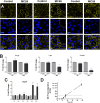Induced Pluripotent Stem Cell-Derived Brain Endothelial Cells as a Cellular Model to Study Neisseria meningitidis Infection
- PMID: 31191497
- PMCID: PMC6548865
- DOI: 10.3389/fmicb.2019.01181
Induced Pluripotent Stem Cell-Derived Brain Endothelial Cells as a Cellular Model to Study Neisseria meningitidis Infection
Abstract
Meningococcal meningitis is a severe central nervous system infection that occurs when Neisseria meningitidis (Nm) penetrates brain endothelial cells (BECs) of the meningeal blood-cerebrospinal fluid barrier. As a human-specific pathogen, in vivo models are greatly limited and pose a significant challenge. In vitro cell models have been developed, however, most lack critical BEC phenotypes limiting their usefulness. Human BECs generated from induced pluripotent stem cells (iPSCs) retain BEC properties and offer the prospect of modeling the human-specific Nm interaction with BECs. Here, we exploit iPSC-BECs as a novel cellular model to study Nm host-pathogen interactions, and provide an overview of host responses to Nm infection. Using iPSC-BECs, we first confirmed that multiple Nm strains and mutants follow similar phenotypes to previously described models. The recruitment of the recently published pilus adhesin receptor CD147 underneath meningococcal microcolonies could be verified in iPSC-BECs. Nm was also observed to significantly increase the expression of pro-inflammatory and neutrophil-specific chemokines IL6, CXCL1, CXCL2, CXCL8, and CCL20, and the secretion of IFN-γ and RANTES. For the first time, we directly observe that Nm disrupts the three tight junction proteins ZO-1, Occludin, and Claudin-5, which become frayed and/or discontinuous in BECs upon Nm challenge. In accordance with tight junction loss, a sharp loss in trans-endothelial electrical resistance, and an increase in sodium fluorescein permeability and in bacterial transmigration, was observed. Finally, we established RNA-Seq of sorted, infected iPSC-BECs, providing expression data of Nm-responsive host genes. Altogether, this model provides novel insights into Nm pathogenesis, including an impact of Nm on barrier properties and tight junction complexes, and suggests that the paracellular route may contribute to Nm traversal of BECs.
Keywords: Neisseria meningitidis; bacteria; blood-brain barrier; blood-cerebrospinal fluid barrier; brain endothelial cells; meningococcus; stem cells.
Figures





Similar articles
-
Development of a multicellular in vitro model of the meningeal blood-CSF barrier to study Neisseria meningitidis infection.Fluids Barriers CNS. 2022 Oct 26;19(1):81. doi: 10.1186/s12987-022-00379-z. Fluids Barriers CNS. 2022. PMID: 36289516 Free PMC article.
-
Neisseria meningitidis Infection of Induced Pluripotent Stem-Cell Derived Brain Endothelial Cells.J Vis Exp. 2020 Jul 14;(161). doi: 10.3791/61400. J Vis Exp. 2020. PMID: 32744533
-
Induced Pluripotent Stem Cell (iPSC)-Derived Endothelial Cells to Study Bacterial-Brain Endothelial Cell Interactions.Methods Mol Biol. 2022;2492:73-101. doi: 10.1007/978-1-0716-2289-6_4. Methods Mol Biol. 2022. PMID: 35733039
-
Neisseria meningitidis colonization of the brain endothelium and cerebrospinal fluid invasion.Cell Microbiol. 2013 Apr;15(4):512-9. doi: 10.1111/cmi.12082. Epub 2012 Dec 24. Cell Microbiol. 2013. PMID: 23189983 Review.
-
Molecular mechanisms involved in the interaction of Neisseria meningitidis with cells of the human blood-cerebrospinal fluid barrier.Pathog Dis. 2017 Mar 1;75(2). doi: 10.1093/femspd/ftx023. Pathog Dis. 2017. PMID: 28334198 Review.
Cited by
-
Host-microbe interactions at the blood-brain barrier through the lens of induced pluripotent stem cell-derived brain-like endothelial cells.mBio. 2024 Feb 14;15(2):e0286223. doi: 10.1128/mbio.02862-23. Epub 2024 Jan 9. mBio. 2024. PMID: 38193670 Free PMC article. Review.
-
Human in vitro blood barrier models: architectures and applications.Tissue Barriers. 2024 Apr 2;12(2):2222628. doi: 10.1080/21688370.2023.2222628. Epub 2023 Jun 20. Tissue Barriers. 2024. PMID: 37339009 Free PMC article. Review.
-
The Host-Pathogen Interactions and Epicellular Lifestyle of Neisseria meningitidis.Front Cell Infect Microbiol. 2022 Apr 22;12:862935. doi: 10.3389/fcimb.2022.862935. eCollection 2022. Front Cell Infect Microbiol. 2022. PMID: 35531336 Free PMC article. Review.
-
Reactive astrocytes transduce inflammation in a blood-brain barrier model through a TNF-STAT3 signaling axis and secretion of alpha 1-antichymotrypsin.Nat Commun. 2022 Nov 2;13(1):6581. doi: 10.1038/s41467-022-34412-4. Nat Commun. 2022. PMID: 36323693 Free PMC article.
-
Virulence Factors of Meningitis-Causing Bacteria: Enabling Brain Entry across the Blood-Brain Barrier.Int J Mol Sci. 2019 Oct 29;20(21):5393. doi: 10.3390/ijms20215393. Int J Mol Sci. 2019. PMID: 31671896 Free PMC article. Review.
References
-
- Appelt-Menzel A., Cubukova A., Günther K., Edenhofer F., Piontek J., Krause G., et al. (2017). Establishment of a human blood-brain barrier co-culture model mimicking the neurovascular unit using induced pluri- and multipotent stem cells. Stem Cell Rep. 8 894–906. 10.1016/j.stemcr.2017.02.021 - DOI - PMC - PubMed
Grants and funding
LinkOut - more resources
Full Text Sources
Molecular Biology Databases
Research Materials

